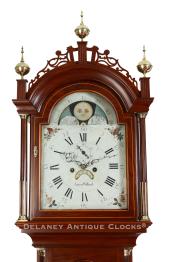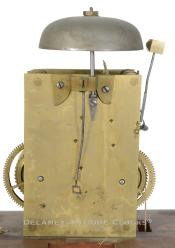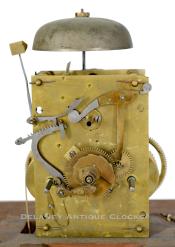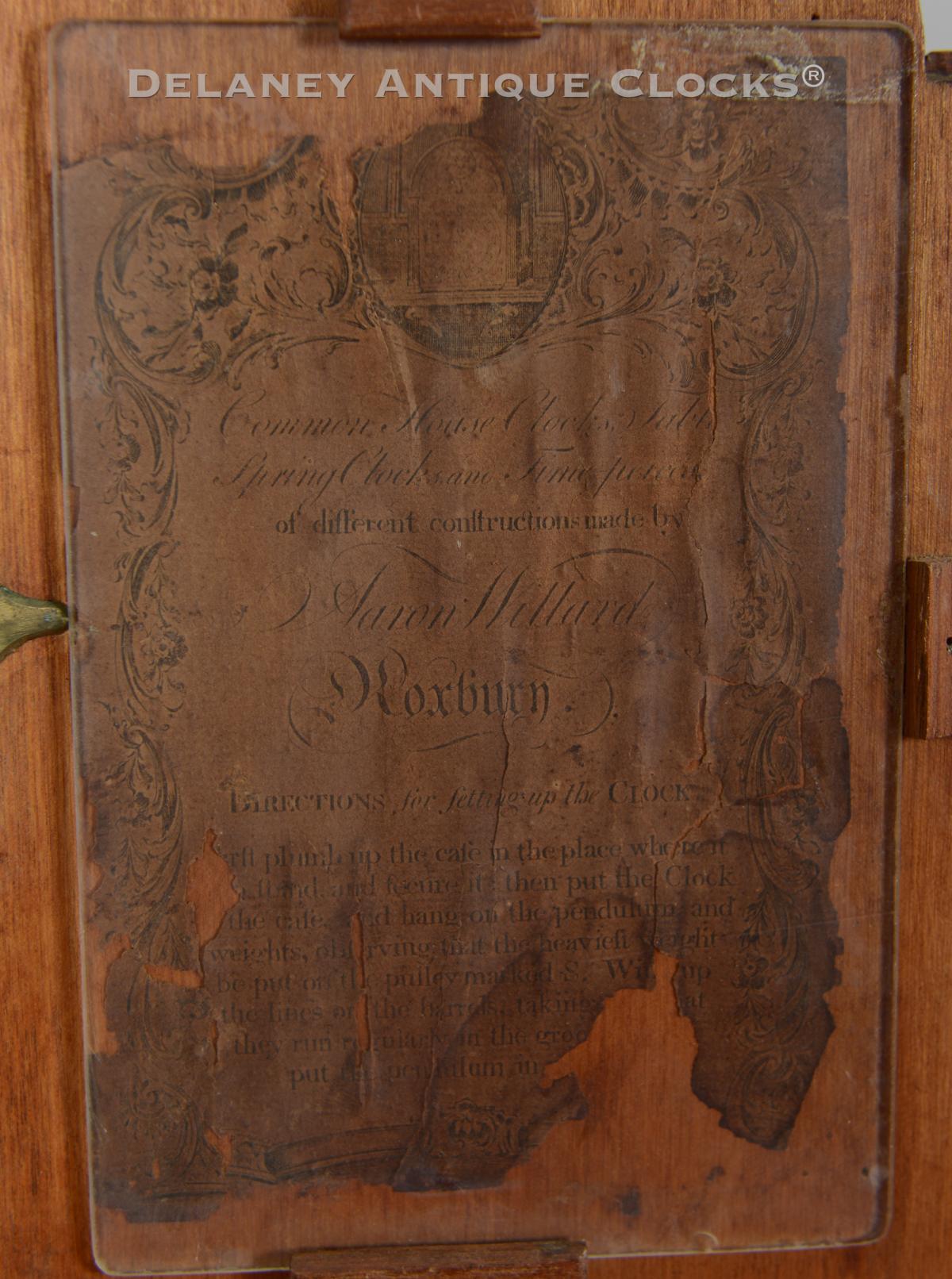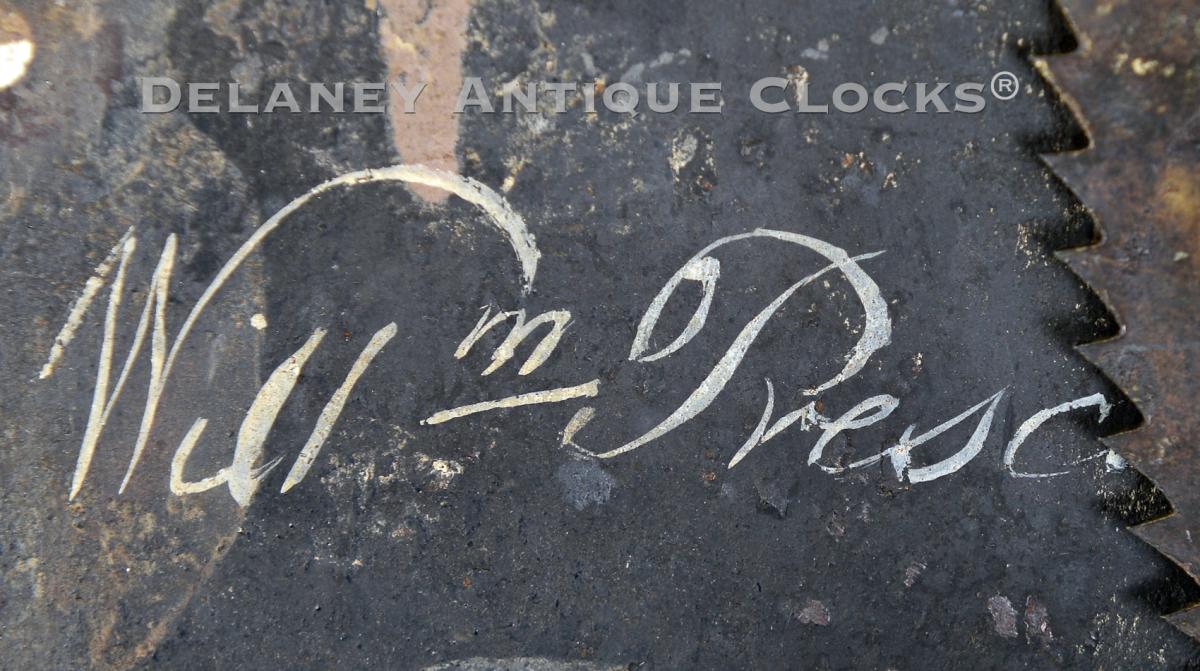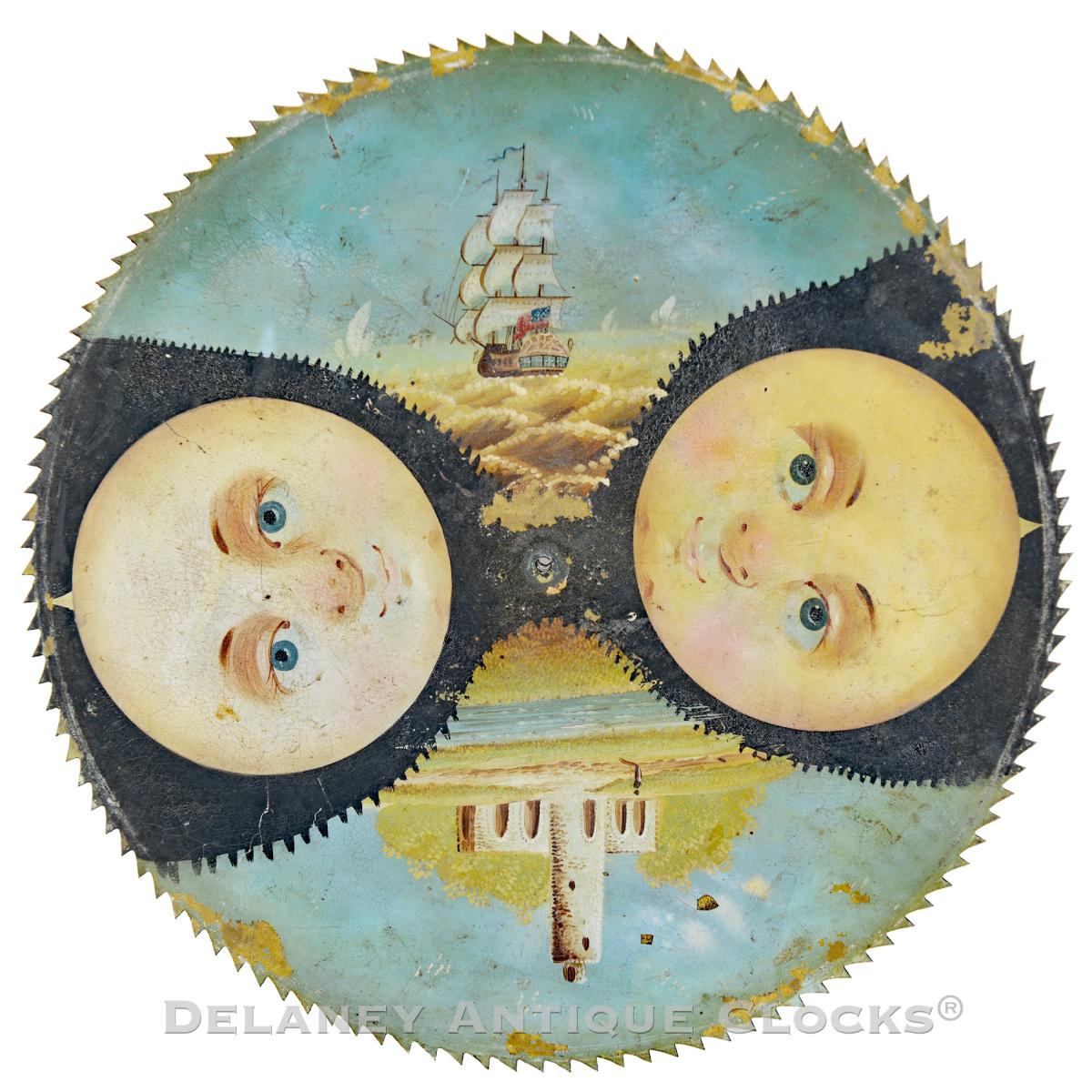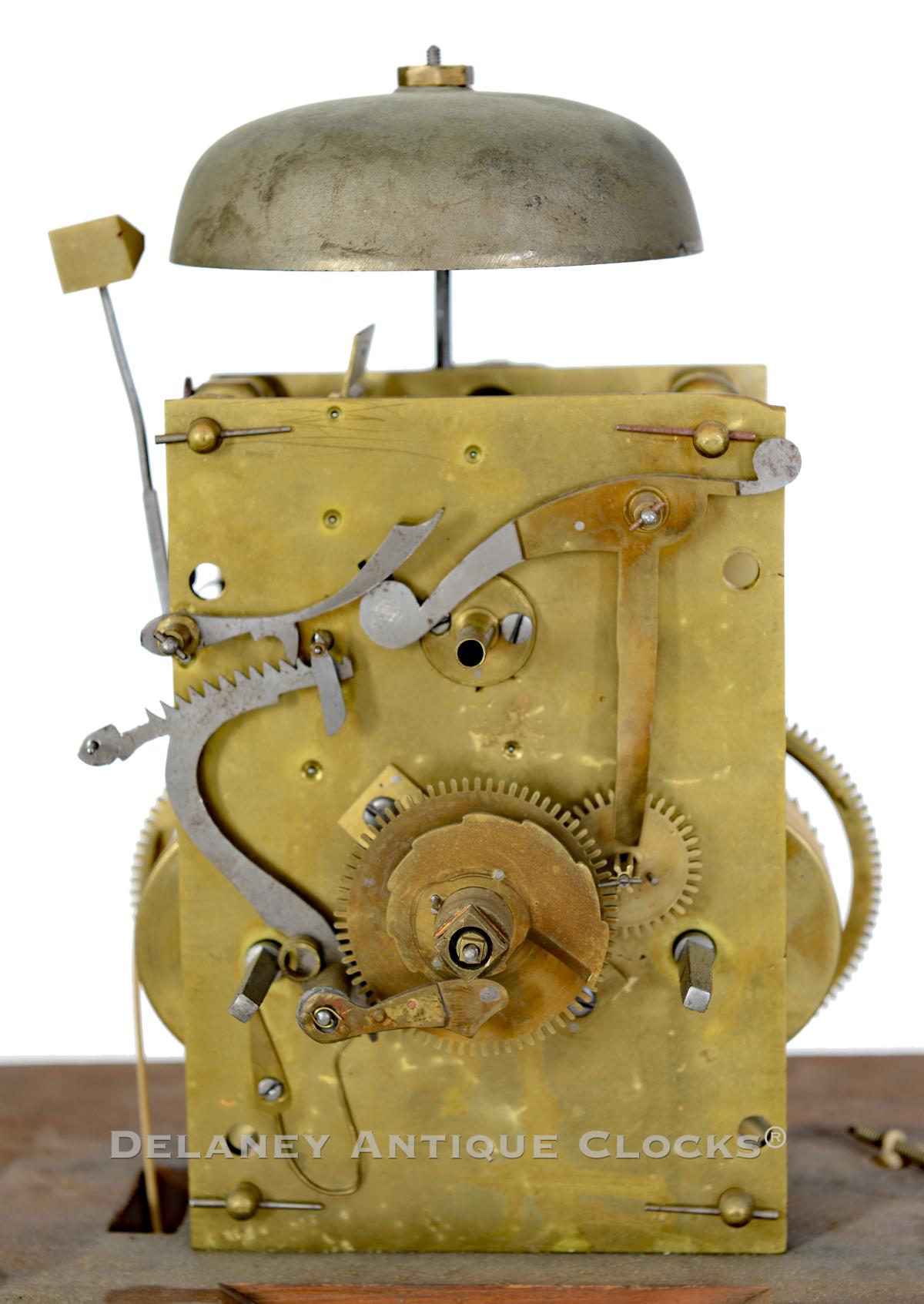Aaron Willard tall case clock with lunar calendar dial made in Roxbury, Massachusetts. William Prescott, dial painter. Revere printed setup label. DDD-19.
Aaron Willard of Roxbury, Massachusetts, made this important labeled mahogany case tall clock. This clock was once owned by Warren W. Creamer of Waldoboro, Maine. An antiques dealer in 1925 and author ofNew England Antiques: Including the Reed Family Heirlooms: Early American Furniture: Historical and Pedigreed Pieces, Including Many Heirlooms of the Reed Family, Waldoboro, Maine, published by American Art Association/Anderson Galleries, New York, 1930.
This is a classic Roxbury example. This case exhibits excellent proportions constructed by the Roxbury School of cabinetmakers. This case, retaining a restored surface, measures approximately 7 feet 9 inches or 93 inches tall to the top of the center finial, 20 inches wide, and 9.75 inches deep. The dial measures the standard 12 inches across.
This mahogany case is in excellent original condition. The case stands on four nicely formed ogee bracket feet, which are original to this clock. The feet are applied to the bottom of the double-step molding on the base of the case. The base panel features good vertical graining in long, gentle lines. The center of this panel is decorated with parquetry inlay. An inlaid half-fan is designed with 13 blades of alternating light and dark colors. The long tombstone-shaped waist door is vertical-grained. The grain pattern chosen for this location is vibrant and swirls upwards. The edge of this door is fitted with an applied molding. One would open this door to access the inside of the case. Here, the original wooden pendulum rod, brass-faced bob, rating nut, and two tin can weights are accessible. On the back of this door is the Maker’s setup label. This version is associated with being engraved by the American Patriot Paul Revere. (Current speculation refutes this claim. To reference this discussion, please read Richard W. Philbrick’s article, Simon Willard’s Astronomical Shelf Timekeeper in Herschel B. Burt’s Eighteenth Century, Thirty-Hour Willard Clocks 1770-1790.) Very few Willard clocks retain their original setup labels. This is an important additional detail. This label lists the working location as “Roxbury.”
Aaron Moved to Boston in 1792, so this clock was likely made before his relocation. The sides of the case are fitted with the traditionally formatted brass stop-fluted quarter columns. Both terminate in quarter capitals. The bonnet features a pierced and open fretwork design, which is original to this example. It is supported by three fluted plinths surmounted by three brass finials. The finials are period. Fully turned and brass stop fluted bonnet columns visually support the upper bonnet molding. They are mounted in brass capitals and are free-standing. Nicely turned quarter columns are set into the back of the bonnet. The sides are fitted with tombstone-shaped side lights. The arched bonnet door is decorated with line inlay, fitted with glass, and opens to access the painted iron dial.
This painted iron dial is a locally made product. The Artist signed the back of the dial, “Willm Prescott N 2.” William Prescott is an elusive fellow. We currently know very little about his life. This signature suggests that this is the second dial he painted. We have recorded several other signed Prescott dials. The highest number recorded to date is number 20. This number 2 dial provides additional clues. The Aaron Willard dial is labeled “Roxbury” in Aaron Willard’s case, suggesting he was painting before Aaron moved to Boston in 1792. Paul Foley located an advertisement in the February 19, 1798 Independent Chronicle. This Boston paper advertises the partnership of Daniel Munroe Junior and Prescott. At this time, they were located in Concord, Mass. The partnership was dissolved on February 16, 1798. It appears William Prescott died in Concord five years later, in 1803.
This painted iron dial features floral-themed spandrels. Interestingly, this decoration is not framed with gilt borders like the traditional imported English dials of the period. The time track is formatted with Arabic five-minute markers. These are separated from the Roman-style hours by a dotted minute ring. The seconds display and the calendar dates are positioned in the traditional locations. The clockmaker’s name is signed across the center, “Aaron Willard.” A moon phase mechanism or lunar calendar is in the arch of this dial. The lunar calendar or moon phase mechanism is a mechanical almanac. This feature was most likely made on special order due to the extra work involved in producing it. This display would have been valuable to several occupations during the colonial era. Farmers were known to track the moon phase to anticipate the days that offered the most available moonlight. A bright night would be more beneficial to them in scheduling the tilling and harvesting of their fields. Sailors and merchants track the lunar phases to know when the high tide would allow their ships to sail easily from a port or when the fishing might be best. Numerous religious groups had an almost superstitious litany of rituals best performed by lunar events. The lunar month represents an inconvenient interval of 29 days, 12 hours, 44 minutes, and 2.8 seconds. A tall clock’s lunar calendar is set constant at 29.5 days, which represents a complete cycle. As a result, a 9-hour setback is required at the end of a single year to keep the lunar display current.
This movement is constructed in brass and is of good quality. It is weight-driven and designed to run for eight days on a full wind. It is a time-and-strike design with a rack and snail striking system. As a result, it will strike each hour on the hour. This is done on a cast iron bell mounted above the movement. The hammer is returned to the ready position via a coil spring.
This beautiful clock was made circa 1790. It stands approximately 7 feet 9 inches tall to the top of the center finial.
Inventory Number DDD-119.
Aaron Willard was born in Grafton, Massachusetts, on October 13, 1757. Little is currently known of Aaron's early life in Grafton. His parents, Benjamin Willard (1716-1775) and Sarah (Brooks) Willard (1717-1775) of Grafton had eleven children. Aaron was one of four brothers that trained as a clockmaker. In Grafton, he first learned the skills of clock-making from his older brothers Benjamin and Simon. It is recorded that Aaron marched with them in response to the Lexington Alarm on April 19, 1775, as a private under Captain Aaron Kimball's Company of Colonel Artemus Ward's Regiment. Aaron re-enlisted on April 26 and was soon sent by General George Washington as a spy to Nova Scotia in November. By this time, he had reached the grade of Captain. He soon returned to Grafton to train as a clockmaker. In 1780, Aaron moved from Grafton to Washington Street in Roxbury along with his brother Simon. Here the two Willards establish a reputation for themselves as fine clock manufacturers. They were both responsible for training a large number of apprentices. Many of these became famous clockmakers in their own right. The Willards dominated the clock-making industry in the Boston area during the first half of the nineteenth century. Aaron worked in a separate location in Roxbury from his brother and, in 1792, relocated about a quarter-mile away from Simon's shop across the Boston line. Aaron is listed in the 1798 Boston directory as a clockmaker "on the Neck," His large shop employed up to 30 people, while 21 other clockmakers, cabinetmakers, dial and ornamental painters, and gilders worked within a quarter-mile radius by 1807.
Some important dates for Aaron Willard include...
1783, Aaron married Catherine Gates. They have two children. The first is Aaron Willard Jr who becomes a very accomplished clockmaker. Catherine Gates dies in 1785.
1789, Aaron marries Polly Patridge. Polly has two sisters that also marry clockmakers Abel Hutchins and Elnathan Taber. Aaron and Polly have nine children. Two work-in-the-clock trades. George Willard 1817-1821 becomes a journeyman clockmaker. Henry Willard (1822-1887) trained as a cabinetmaker and made cases for the Willard operation when he came of age.
1792, Aaron builds a large home at 143 Washington Street in Boston. He lives in this house until he dies. This house is also the location of his workshop. A barn is converted into an area to finish wood. Other spaces in the carriage shop are rented to related artisans.
1802-1804, Aaron is in a business partnership with cabinetmaker James Blake as Willard & Blake. Aaron's position is financial.
1804, Aaron he transforms the carriage house and barn into a workshop space for artists, clockmakers, woodworkers, etc. It is now known as Willard's Compound.
1805-1806, Aaron is a financial backer in the partnership of Willard & Nolen. Spencer Nolen (1784-1849) is an ornamental artist who begins painting clock dials. In 1808, Spencer Nolen married Aaron Willard's daughter.
1823, Aaron Willard retires. He is 66 years old.
1844, Aaron died on May 20 and is buried in the Eustis Cemetery in Roxbury.
We have owned a large number of tall case clocks made by this important Maker. In addition, we have also owned a good number of wall timepieces, some in the form of banjo clocks, gallery clocks, as well as numerous Massachusetts shelf clock forms.





